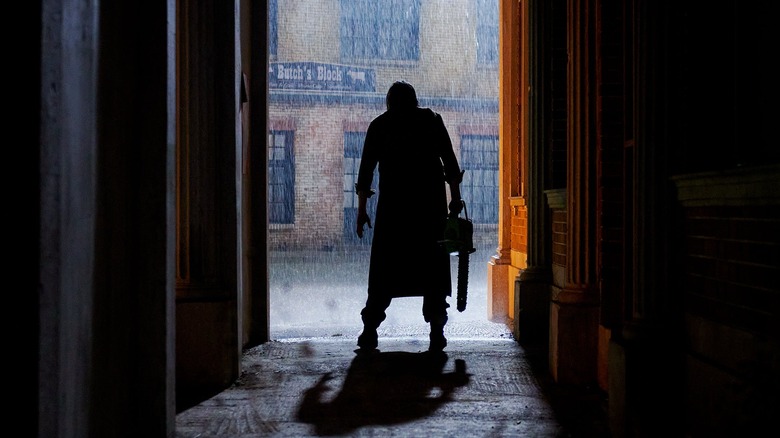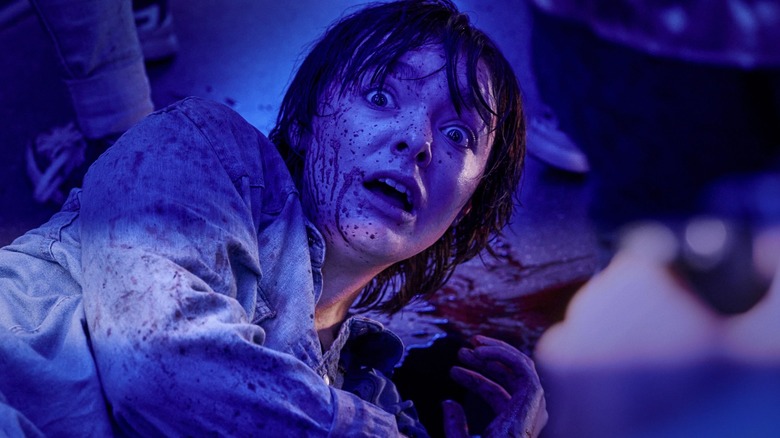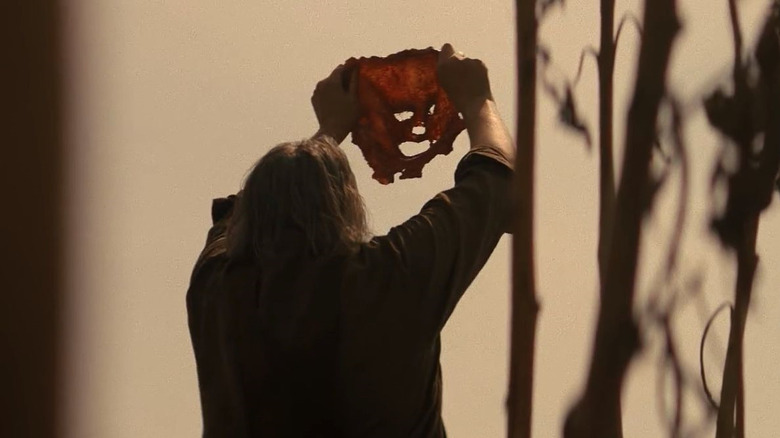The Texas Chainsaw Massacre Scene That Hit Fans The Hardest
It's clear from the film's opening that David Blue Garcia's "Texas Chainsaw Massacre" is situated within the universe of Tobe Hooper's 1974 original, "The Texas Chain Saw Massacre." Colin Stetson's rumbling score kicks in with humming horns, almost like an old machine coming to life again before grainy old footage fires up on a tv, and John Larroquette reprises his role as narrator from the intro of Hooper's film, detailing the "grisly and gruesome" attacks on a group of youths in August of 1973.
The first two minutes of the film re-introduce the lone '74 "Chainsaw" survivor Sally Hardesty (played by Olwen Fouéré following the death of Marilyn Burns in 2014), now an older and more grizzled survivalist version of herself, a legacy slasher sister to Laurie Strode of the recently resurrected "Halloween" franchise. The camera pulls out from the television preamble to reveal an "I Love Texas" shirt with a chainsaw and a Lone Star state outline in place of the heart symbol, signaling an intent to sit at the meta kids' table with the self-referencing "Scream" (2022) and David Gordon Green's "Halloween" and "Halloween Kills."
New blood has arrived in a group of gentrifying, vlogging entrepreneurs who come to Harlow, Texas in order to turn the town's frown upside down with trendy businesses and the wealthier residents they'll bring in — even if it means displacing the locals. Through a series of unfortunate events, the youths get on Leatherface's bad side, and even though the Large Adult Son has been dormant for nearly fifty years, he can still mightily swing a Husqvarna.
"Texas Chainsaw" is aware of itself and aware of its legacy, and so there were certain boxes to tick. Leatherface? Check. Elements from Tobe Hooper's original film? Check and check. But fans and detractors alike can't stop talking about one scene in particular: what might be the first proper chainsaw massacre in the whole franchise.
Welcome to the Pain Wagon
Leatherface's introduction in Hooper's original stands tall as one of the scariest scenes of all time, but every entry in the "Texas Chainsaw" pantheon has its memorable moments, from Dennis Hopper double-fisting chainsaws in Hooper's 1986 sequel to Ken Foree kicking butt and taking names in "Leatherface: The Texas Chainsaw Massacre III" four years later, and R. Lee. Ermey's barking Sawyer family patriarch in the 2003 Platinum Dunes remake. There was plenty of material to pull from, but "Texas Chainsaw Massacre" acts as a direct sequel to Hooper's original film and disregards the seven sequels and iterations that came before it. The task was to connect the old to the new and come up with a way to thrill modern audiences. A few scenes make the effort: a new, somewhat likable character is viciously dispatched with a sledgehammer, another is stabbed in the throat with his own shattered forearm. But in all of these movies, victims are picked off piecemeal, maybe a twofer if Leatherface is feeling froggy.
Finally, in 2022, a real Texas chainsaw massacre pops off onscreen.
Leatherface, still strong enough to launch that sledgehammer like a Frisbee, is tired of these kids on his lawn, and he decides to inform the youths that their time in Harlow has come to an abrupt end. While the gentrifying squadron celebrates their brand aboard a party bus, Melody (Sarah Yarkin) and Lila (Elsie Fisher) climb on, the former having just escaped from Leatherface's spinning blades. She urges the driver to take off, but he's unable to keep his head. Soon, the sawman steps in to formally decline the entrepreneurs' plans for Harlow.
In a stunning five-minute festival of sick-making, he signs this letter with the saw, making sure every single passenger aboard gets the memo. A Millennial warns the 6'7" butcher, "Try anything and you're canceled, bro," but his cringiness is handled deftly with a single thrust of the blade. After claiming his first victim, Leatherface turns the party bus into the pain wagon, slicing and dicing his way through eighteen would-be investors. Amid the mayhem, a man is hoisted onto the saw until his body slams into the bus ceiling, a pair of screaming victims are impaled together, and one unfortunate woman is bisected as she crawls through a window. Her top half does escape the bus, though.
Why does it work?
The scene lands well with audiences for similar reasons as the jailhouse massacre in "Malignant" and the firemen massacre in "Halloween Kills"; there's nothing like a group kill to make the man mythic.
Gabriel's just a growth, how malignant could he be? Is Michael Myers really the Boogeyman if he limits his kills to a hospital orderly and a couple of babysitters? In order for these killers to advance beyond "some guy with a knife and Timbs" and "nasty scalp issue" in the public eye, there must be some incredible feats of power. But David Gordon Green's "Halloween" and Garcia's "Texas Chainsaw Massacre" share a special imperative that James Wan didn't have to contend with in "Malignant": they have to convince modern, jaded horror audiences that these angry old men are still worth watching, and that requires some flexing.
Cancel culture jokes aside, and regardless of how well the rest of the movie runs with this myth-making, the bus massacre sequence delivers buckets of blood and reasserts Leatherface as the iconic raging juggernaut who stormed through the nightmares of generations.


